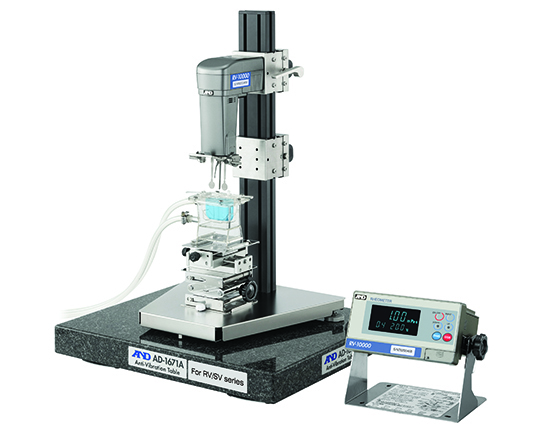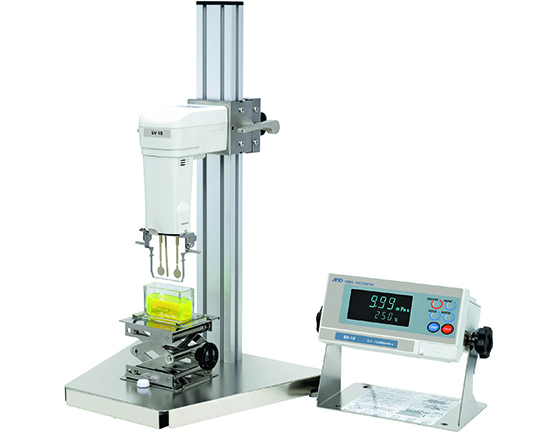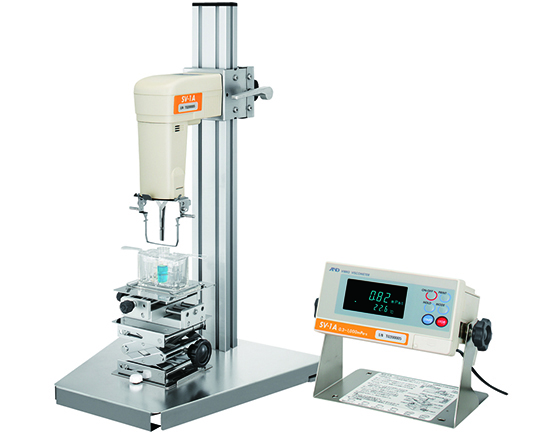
Drawing on A&D’s proven sensor technology for high-resolution analytical balances, the RV-10000A Tuning Fork Vibro Rheometer is a breakthrough alternative to conventional methods in the research of non-Newtonian fluid properties.

Revolutionary range of viscometer featuring the vibrating tuning fork measurement method. The SV Series provides a fast highly accurate result and is simple to use. Ideal for non Newtonian products particularly those with a volatile nature.

The SV-A is the latest addition to the family of revolutionary Sine Wave Vibro Viscometers. The SV-10 and SV-100 have introduced a ground breaking new discipline to the viscometry market with their ease of operation, high accuracy and fast testing times.
What is a Viscometer or Rheometer?
A viscometer or Rheometer is an instrument used to measure the properties of fluids such as viscosity, elasticity, and flow behavior. These instruments are commonly used in industrial settings, research laboratories, and quality control processes to ensure consistent product quality.
Viscosity is a measure of a fluid’s resistance to flow. It is essentially a measure of how thick or thin a fluid is. The thicker the fluid, the higher its viscosity. Viscosity is an important property of fluids as it can affect how they flow and behave in different environments.
Viscosity Measurement
Viscosity measurement is crucial in various industries such as food and beverage, pharmaceuticals, cosmetics, paints and coatings, and oil and gas. In the food industry, for example, viscosity measurements are used to ensure consistent product texture and quality. In the pharmaceutical industry, viscosity measurements help determine the correct dosage of medication.
Rheometers are similar instruments to viscometers but with added capabilities to measure the flow behavior of fluids under different conditions. This includes measuring viscosity as a function of shear rate, temperature, and time. These are commonly used in research and development processes to study the behavior of complex fluids such as polymers, gels, and emulsions.
The design and operation of viscometers and Rheometers vary depending on the type of fluid being measured and the desired measurements. Some common types include rotational viscometers, capillary viscometers, and falling-sphere viscometers. Each type has its advantages and limitations, making it suitable for different applications.
Viscometers and Rheometers used for Food Systems
When it comes to food systems, a few key viscometers and rheometers stand out for their consistent accuracy and wide applicability. Commonly used viscometers and rheometers for food systems include the Brookfield viscometer, Cone and Plate Rheometer, and many more. These instruments can measure viscosity accurately for a wide range of food products such as sauces, dressings, and dairy products. They are also designed to handle non-Newtonian fluids, which have a varying viscosity depending on the applied force. These are –
Brookfield Viscometer:
This is perhaps the most universally recognized viscometer, known for its versatility and ease of use. It uses a rotating spindle to measure the resistance of the fluid, thus determining its viscosity. It is extensively used across the food industry, particularly in the manufacturing and quality control of sauces, dressings, and dairy products.
Coaxial rotational viscometer
This type of viscometer consists of two cylinders, an inner rotating cylinder, and an outer stationary cylinder. The viscosity is measured by the torque required to rotate the inner cylinder at a constant speed. This type of viscometer is commonly used for non-Newtonian fluids such as creams, gels, and suspensions.
Falling-sphere viscometer
This type of viscometer measures the viscosity of a fluid by timing the fall of a sphere through the fluid. The faster the sphere falls, the lower the viscosity of the fluid. This type of viscometer is commonly used for low-viscosity fluids such as oils and solvents.
Cone and Plate Rheometer
This type of rheometer is used to measure the viscosity of fluids under different shear rates. It consists of a cone-shaped plate rotating at a constant speed while the fluid is placed between the cone and a flat plate. The resistance to flow is measured and can be used to determine the viscoelastic properties of the fluid.
Capillary Viscometer
This type of viscometer measures the time it takes for a fixed volume of fluid to flow through a capillary tube. The longer the time, the higher the viscosity of the fluid. This type of viscometer is commonly used for transparent fluids such as water and alcohol.

